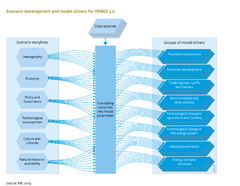Drivers/Model drivers: Difference between revisions
< Drivers
Jump to navigation
Jump to search
m (Text replace - "IntroTableTemplate" to "TableIntroTemplate") |
No edit summary |
||
| Line 9: | Line 9: | ||
The management factor ([[MF]]) describes the actual yield per crop group and per socio-economic region as a multiplier of the maximum potential yield; where the latter is estimated taking inhomogeneous soil and climate data across grid-cells into account. Up to 2005 the MF is estimated as part of the calibration procedure of IMAGE, making use of FAO statistics on actual crop yield and crop area ([[FAO, 2013a]]). The start year level of the MF is then the point of departure for the projection into the future. The most important guidance is provided by assumptions in FAO projections up to 2030 ([[Bruinsma, 2003]]) and extensions to 2050 ([[FAO, 2006]]]). The FAO trends are used as exogenous technical factor in the [[MAGNET model]], and subsequently adjusted to reflect the relative scarcity of suitable land as part of the model calculation. The combination of production volumes and land areas from MAGNET are then adopted to serve as MF projections into the future for IMAGE. However, the FAO estimates are not adopted as is, but revised to reflect substantial differences in underlying drivers between the FAO projection and the IMAGE scenario. For example: much higher income growth in a region than assumed by FAO may be considered less consistent with low and slowly improving MFs for that region. This because strong economic growth is typically facilitated by rapid technology development and deployment, rising wages and a shift from labour from primary production sectors (agriculture) to secondary (industry) and tertiary sectors. Such developments all foster more advanced management and technology in agriculture, with accelerated increase of the MFs. By contrast, stagnating economic development may well imply that MFs would lag behind what the FAO assumes. As the MF is such a decisive factor in the future net agricultural land area, it warrants very careful consideration of uncertainties. | The management factor ([[MF]]) describes the actual yield per crop group and per socio-economic region as a multiplier of the maximum potential yield; where the latter is estimated taking inhomogeneous soil and climate data across grid-cells into account. Up to 2005 the MF is estimated as part of the calibration procedure of IMAGE, making use of FAO statistics on actual crop yield and crop area ([[FAO, 2013a]]). The start year level of the MF is then the point of departure for the projection into the future. The most important guidance is provided by assumptions in FAO projections up to 2030 ([[Bruinsma, 2003]]) and extensions to 2050 ([[FAO, 2006]]]). The FAO trends are used as exogenous technical factor in the [[MAGNET model]], and subsequently adjusted to reflect the relative scarcity of suitable land as part of the model calculation. The combination of production volumes and land areas from MAGNET are then adopted to serve as MF projections into the future for IMAGE. However, the FAO estimates are not adopted as is, but revised to reflect substantial differences in underlying drivers between the FAO projection and the IMAGE scenario. For example: much higher income growth in a region than assumed by FAO may be considered less consistent with low and slowly improving MFs for that region. This because strong economic growth is typically facilitated by rapid technology development and deployment, rising wages and a shift from labour from primary production sectors (agriculture) to secondary (industry) and tertiary sectors. Such developments all foster more advanced management and technology in agriculture, with accelerated increase of the MFs. By contrast, stagnating economic development may well imply that MFs would lag behind what the FAO assumes. As the MF is such a decisive factor in the future net agricultural land area, it warrants very careful consideration of uncertainties. | ||
==Table of drivers== | ==Table of drivers== | ||
{{ | {{DriverTableTemplate}} | ||
}} | }} | ||
Revision as of 17:11, 7 March 2014
Parts of Drivers/Model drivers
| Projects/Applications |
| Models/Databases |
| Relevant overviews |
| Key publications |
| References |
